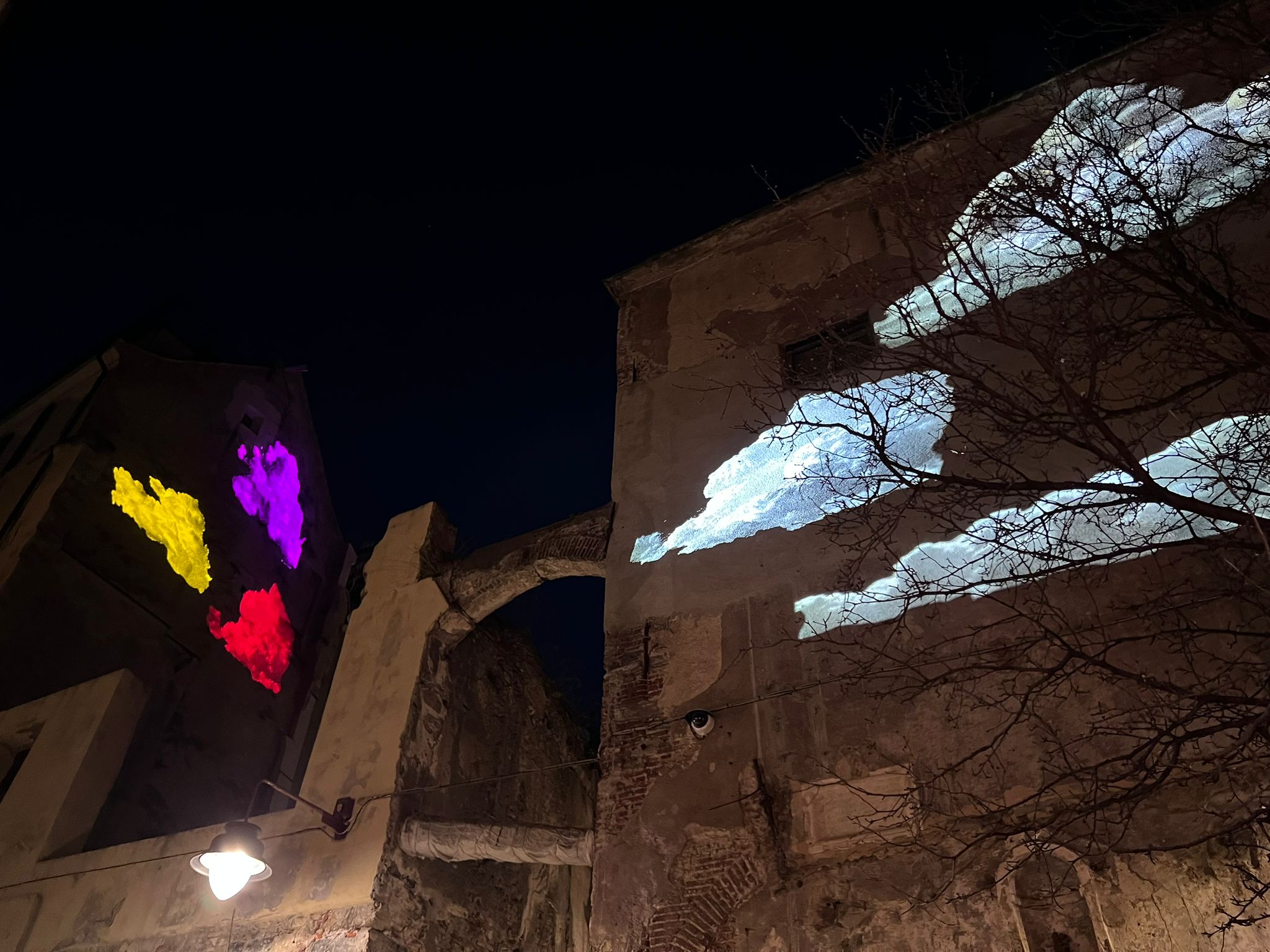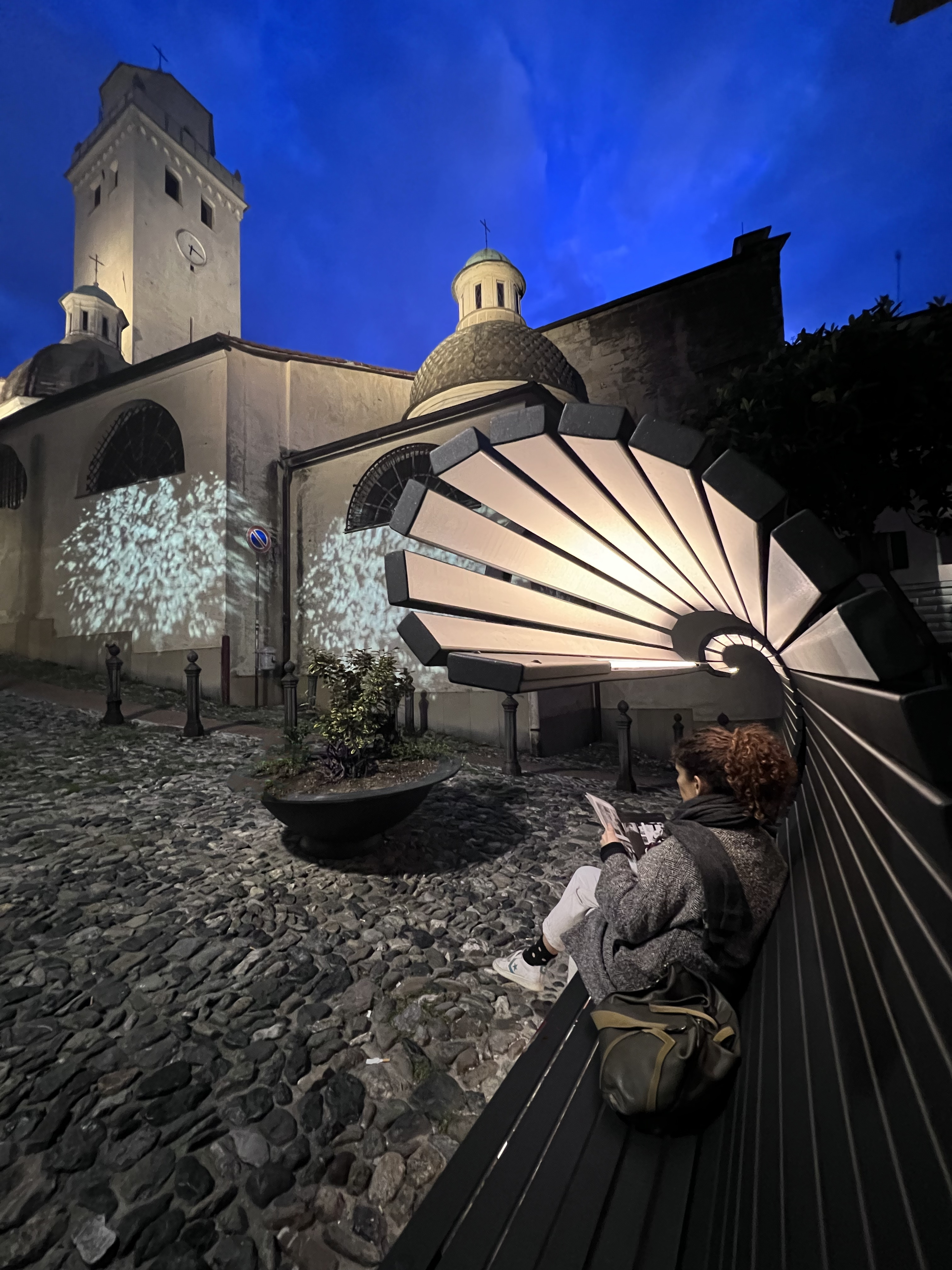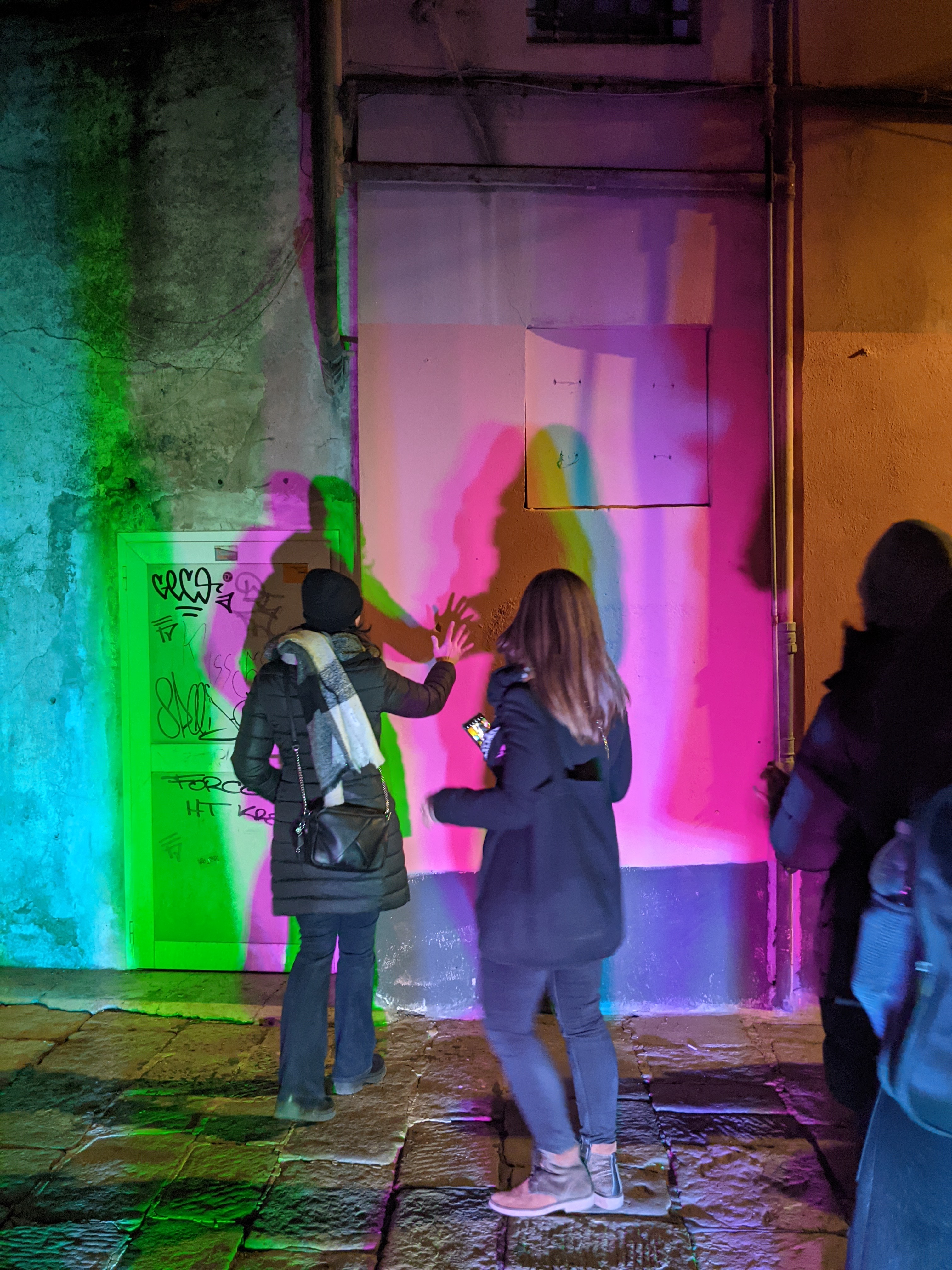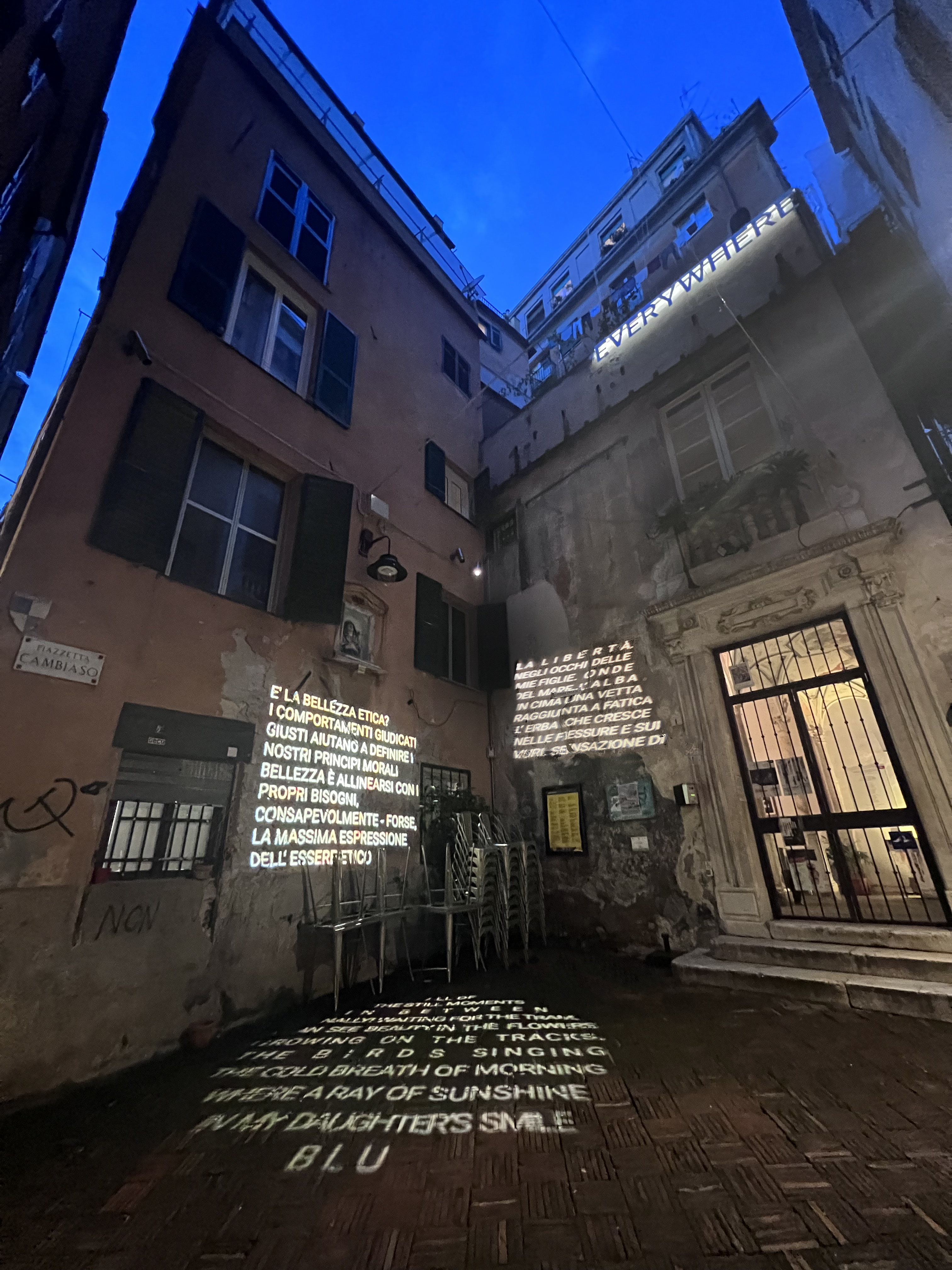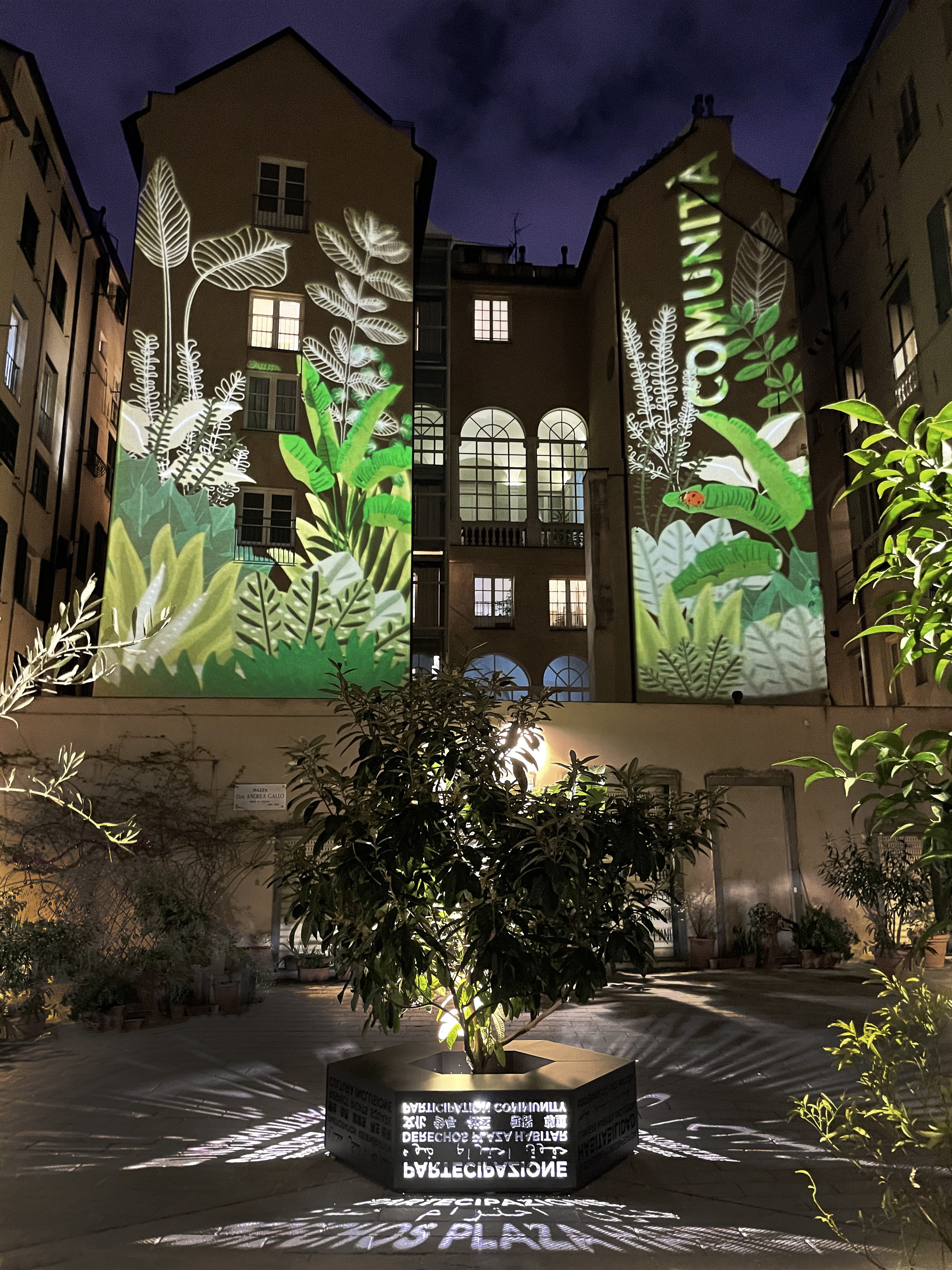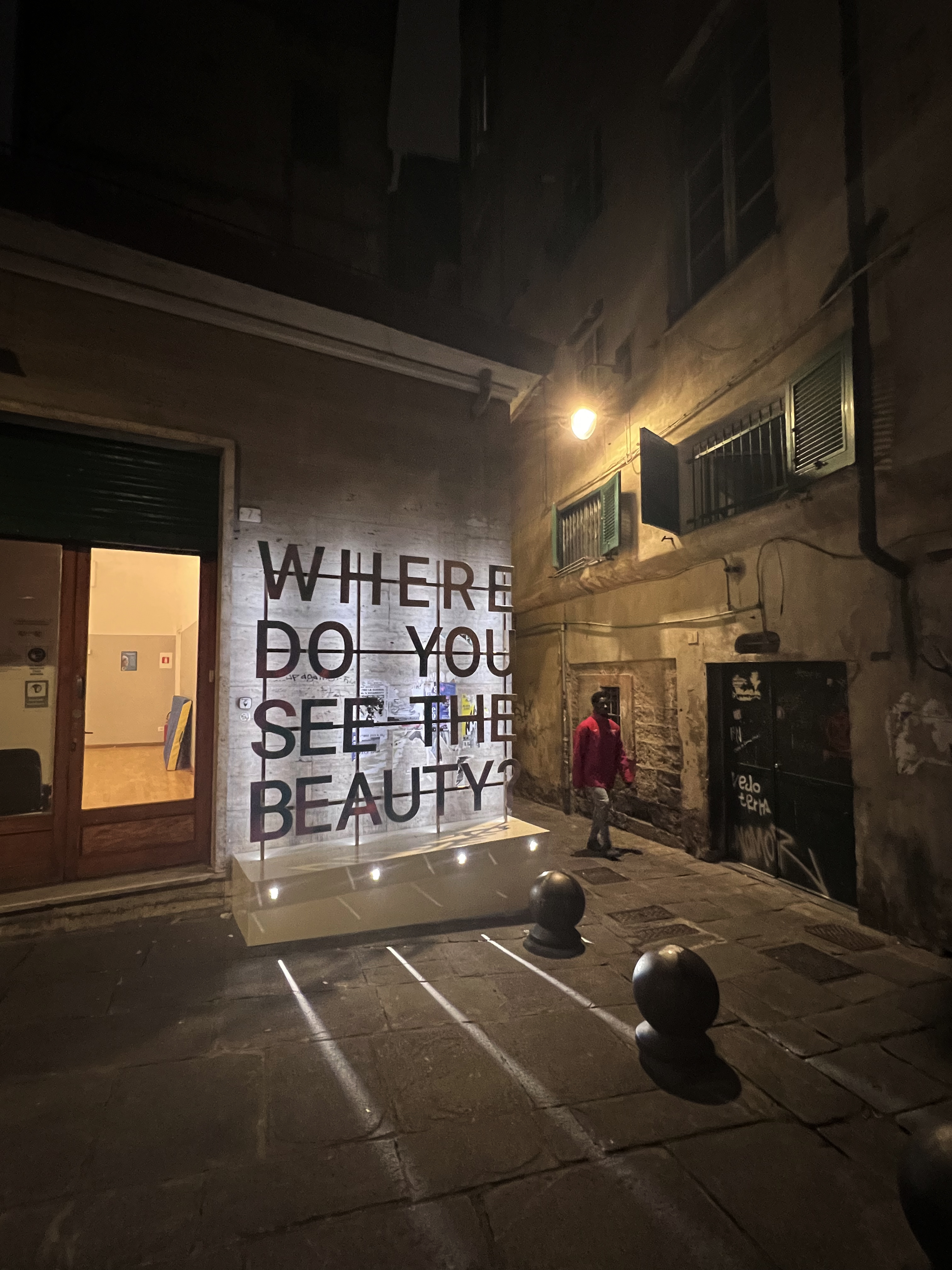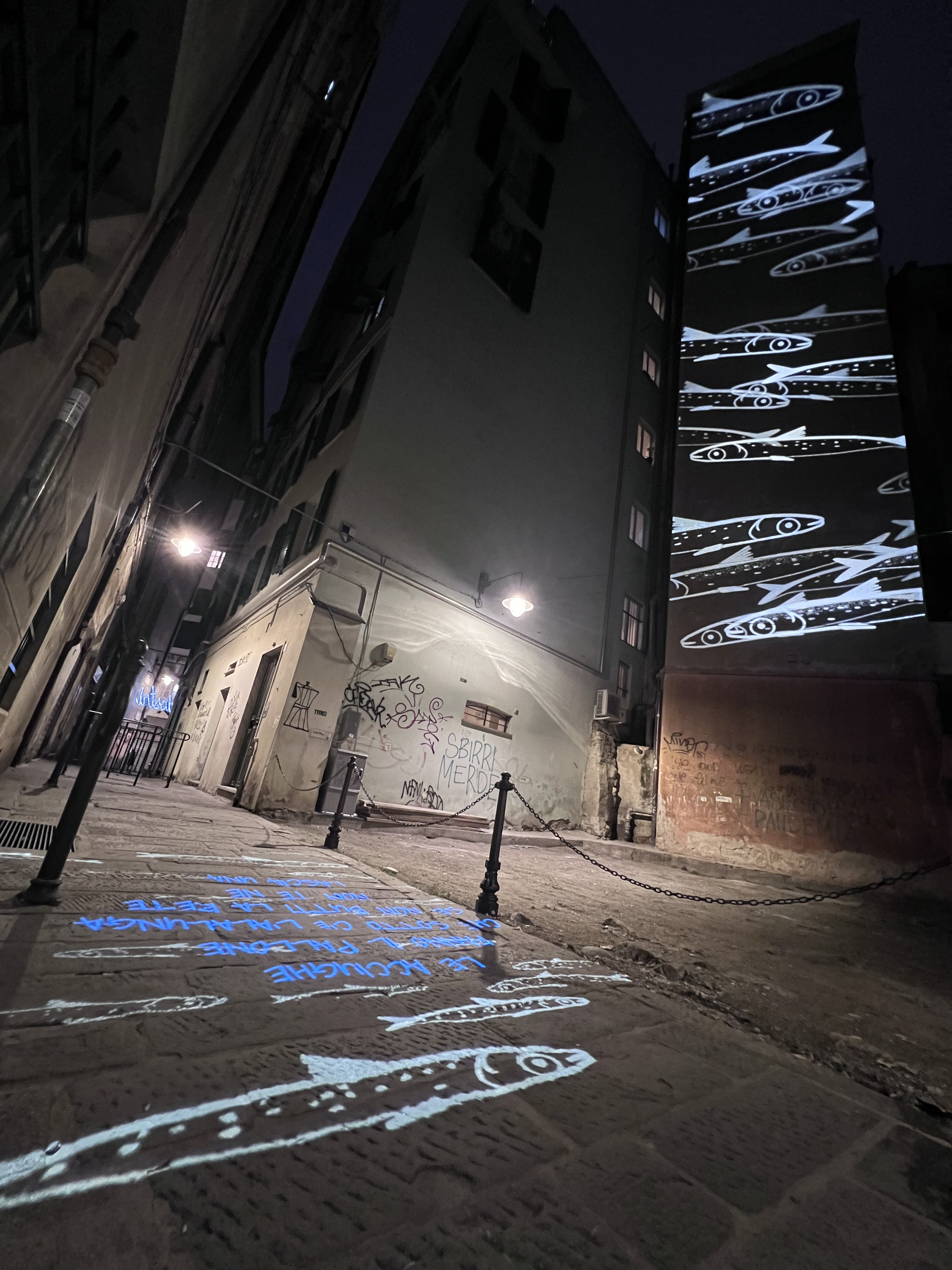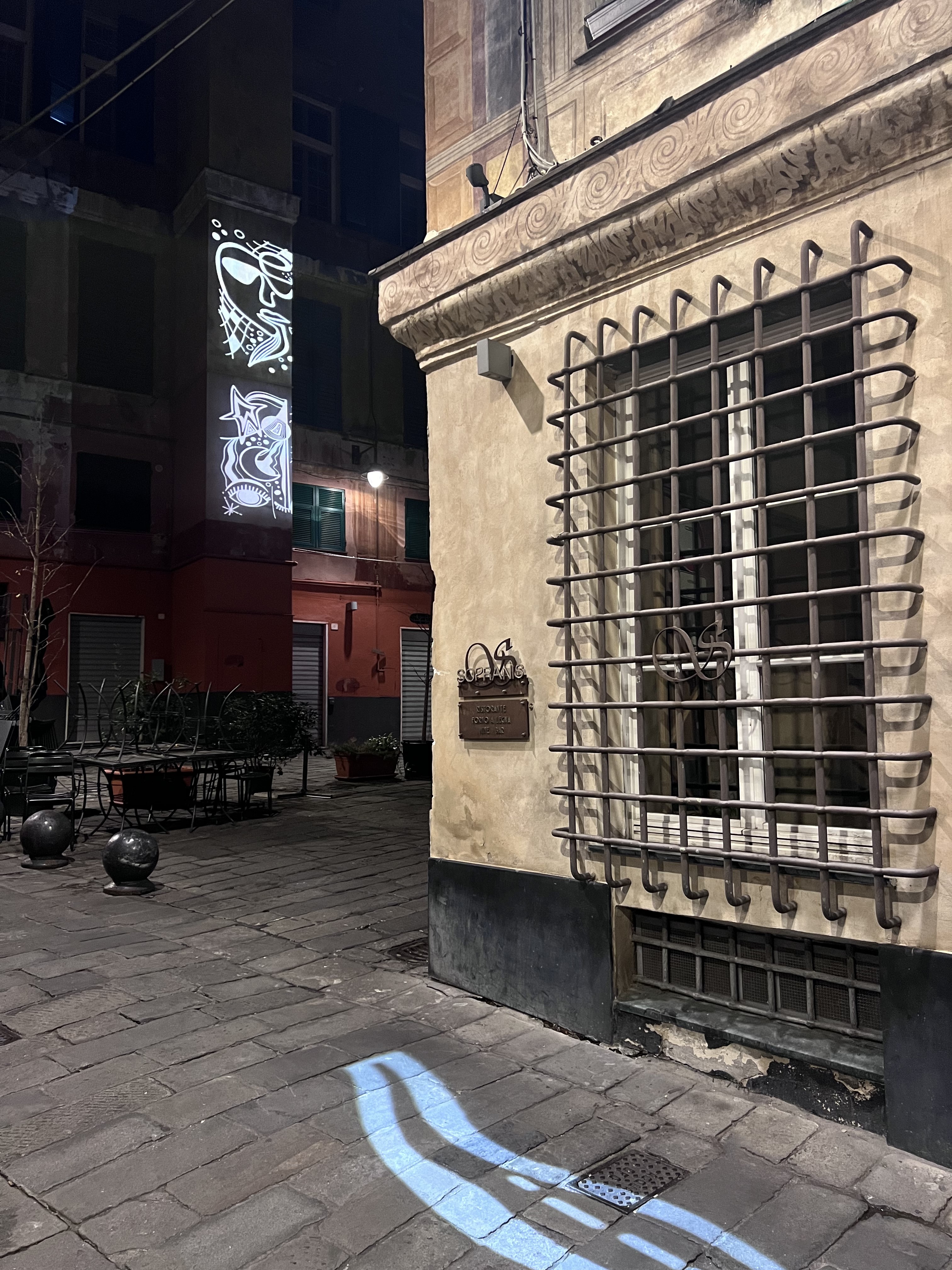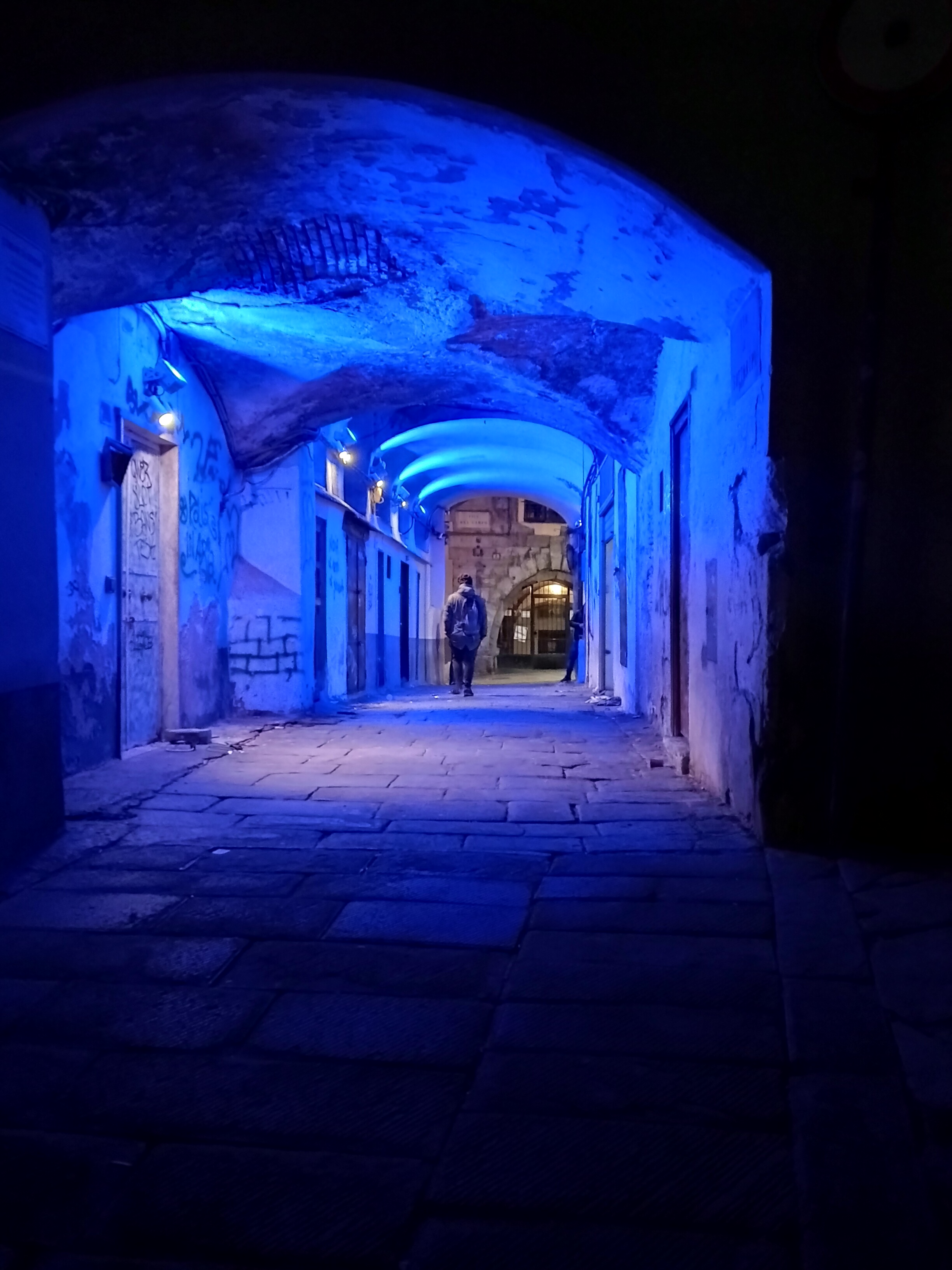Prioritising the places and people that need it the most
Lighting 4 Genoa
1st example of multiple interventions of permanent lighting design as an element of urban regenerati
Project consisting of 9 permanent lighting design interventions in 9 squares in the historic center of Genoa.
The projects were entrusted to 9 different lighting designers belonging to the Women in Lighting Italy network. The installations were designed after listening to the area to understand the needs.
The intent is to make these portions of the city, normally considered critical and poorly frequented, more liveable, creating a greater sense of belonging to those who still live there.
The projects were entrusted to 9 different lighting designers belonging to the Women in Lighting Italy network. The installations were designed after listening to the area to understand the needs.
The intent is to make these portions of the city, normally considered critical and poorly frequented, more liveable, creating a greater sense of belonging to those who still live there.
Italy
Local
Genova (Italy)
Mainly urban
It refers to a physical transformation of the built environment (hard investment)
Yes
2024-06-16
Yes
PON-Metro React EU
No
No
As a representative of an organisation, in partnership with other organisations
The “Lighting for Genoa” project, strongly supported by the municipal administration, aims to redevelop the historic center of Genoa through permanent lighting installations.
The intervention focuses on strategic squares and areas, with the goal of enhancing cultural routes, historical landmarks, and, at the same time, improving safety and the perception of the area.
Light becomes a key tool for making the urban environment safer, more welcoming, and more accessible, particularly for the citizens who live in these areas every day.
The entire project was developed with the active involvement of the citizens, who were the main protagonists in shaping the initiative. Local residents were the first to take care of and maintain the installations, creating a strong bond with the illuminated spaces. In this way, light brought a nighttime narrative to the squares, making the spaces more "human-centered" and fostering an environment of inclusion for everyone, including children, women, and the elderly.
Lighting designers from the international WIL (Women in Lighting) network designed the lighting for the squares with an emotional and evocative approach, interpreting the spaces through light to make people feel safe even at night.
This approach helped reinforce the identity of the neighborhoods and increase residents' sense of belonging. At the same time, visitors who come for the first time are immersed in a visual story that invites them to discover and appreciate the uniqueness of the place.
This initiative represents the first European experience of permanent lighting pathways, aiming to assess the project's effectiveness over time. Additionally, it promotes the culture of light, raising awareness of its importance for urban quality. The hope is that this project can serve as an example for other Italian cities and European countries, contributing to the innovative improvement of urban spaces through lighting.
The intervention focuses on strategic squares and areas, with the goal of enhancing cultural routes, historical landmarks, and, at the same time, improving safety and the perception of the area.
Light becomes a key tool for making the urban environment safer, more welcoming, and more accessible, particularly for the citizens who live in these areas every day.
The entire project was developed with the active involvement of the citizens, who were the main protagonists in shaping the initiative. Local residents were the first to take care of and maintain the installations, creating a strong bond with the illuminated spaces. In this way, light brought a nighttime narrative to the squares, making the spaces more "human-centered" and fostering an environment of inclusion for everyone, including children, women, and the elderly.
Lighting designers from the international WIL (Women in Lighting) network designed the lighting for the squares with an emotional and evocative approach, interpreting the spaces through light to make people feel safe even at night.
This approach helped reinforce the identity of the neighborhoods and increase residents' sense of belonging. At the same time, visitors who come for the first time are immersed in a visual story that invites them to discover and appreciate the uniqueness of the place.
This initiative represents the first European experience of permanent lighting pathways, aiming to assess the project's effectiveness over time. Additionally, it promotes the culture of light, raising awareness of its importance for urban quality. The hope is that this project can serve as an example for other Italian cities and European countries, contributing to the innovative improvement of urban spaces through lighting.
PARTICIPATION
COMMUNITY
RIGHTS
SQUARE
LIVABILITY
The design of the 9 interventions was based on a careful analysis of their environmental impact in terms of energy consumption and light pollution.
Lighting design can directly and indirectly influence various Sustainable Development Goals (SDGs) developed by the UN. Among the direct effects, we observe the impact of light on individuals' health and sense of security, influencing SDG 3 "Good Health and Well-being", and on the staging and perception of the urban environment by people, acting on SDG 11 "Sustainable Cities and Communities".
As for the indirect effects, they depend on the specific context of the intervention. A project that involves all stakeholders, funded by the public sector, and coordinated by a private actor can, for example, contribute to achieving SDG 17 "Partnership for the Goals".
For the creation of the lighting setups in the Lighting for Genoa project, only low-energy (LED) lighting fixtures were selected in order to minimize the impact on urban energy consumption, demonstrating that such actions can be carried out with energy use comparable to that of running a household washing machine.
It was also decided to limit the lighting interventions to a specific time frame, from dusk until midnight, to reduce energy consumption, while also avoiding disturbing the residents in the area and respecting the quiet of the nighttime hours.
Lighting design can directly and indirectly influence various Sustainable Development Goals (SDGs) developed by the UN. Among the direct effects, we observe the impact of light on individuals' health and sense of security, influencing SDG 3 "Good Health and Well-being", and on the staging and perception of the urban environment by people, acting on SDG 11 "Sustainable Cities and Communities".
As for the indirect effects, they depend on the specific context of the intervention. A project that involves all stakeholders, funded by the public sector, and coordinated by a private actor can, for example, contribute to achieving SDG 17 "Partnership for the Goals".
For the creation of the lighting setups in the Lighting for Genoa project, only low-energy (LED) lighting fixtures were selected in order to minimize the impact on urban energy consumption, demonstrating that such actions can be carried out with energy use comparable to that of running a household washing machine.
It was also decided to limit the lighting interventions to a specific time frame, from dusk until midnight, to reduce energy consumption, while also avoiding disturbing the residents in the area and respecting the quiet of the nighttime hours.
The core principle of the entire design process was to increase the sense of belonging to the urban space through design, particularly lighting design. Working on the aesthetics of the place and enhancing the buildings and characteristic volumes of the context helps people develop a greater sense of respect for the space, deeply believing that care generates care, beauty generates beauty, and people are less likely to mistreat public spaces if they are well-maintained, starting from the feelings of the people themselves.
Walking through an urban space, normally dark with low perceived safety, transformed by a scenographic intervention, helps people feel more at home and secure. Working with light on the three-dimensionality of the space, rather than just the horizontal plane, allows people to have a broader view and more easily perceive additional presences along their path.
The historic center of Genoa is one of the largest in Europe, but especially in some areas, it is very degraded. After the scenographic interventions, the municipality decided to create a dedicated circuit for its enhancement—a discovery route of the historic center, even after sunset. This inevitably led to increased foot traffic, as people now visit these squares specifically to explore both the lighting design interventions and the architectural gems and open-air artworks, which, in some cases, were hidden and underappreciated.
Walking through an urban space, normally dark with low perceived safety, transformed by a scenographic intervention, helps people feel more at home and secure. Working with light on the three-dimensionality of the space, rather than just the horizontal plane, allows people to have a broader view and more easily perceive additional presences along their path.
The historic center of Genoa is one of the largest in Europe, but especially in some areas, it is very degraded. After the scenographic interventions, the municipality decided to create a dedicated circuit for its enhancement—a discovery route of the historic center, even after sunset. This inevitably led to increased foot traffic, as people now visit these squares specifically to explore both the lighting design interventions and the architectural gems and open-air artworks, which, in some cases, were hidden and underappreciated.
"Lighting for Genoa" is an innovative inclusive urban design project that transforms the historic center of Genoa through 9 permanent lighting installations, aimed at improving accessibility, safety, and the sense of belonging for the community. The project was exclusively carried out by female lighting designers from Women in Lighting ITALY, challenging traditional gender dynamics in a predominantly male field. Their perspective significantly influenced the design of safer and more welcoming urban spaces where the community can feel involved and respected.
Active community engagement was a fundamental aspect: each installation originated from a consultation process with residents and local businesses. Piazza Don Gallo is an emblematic example of how the project reflects the values of inclusion and respect, with citizens actively participating in the maintenance of the spaces, developing a strong sense of responsibility.
The project celebrates Genoa's multiculturalism, with a focus on the city’s social role as a port. The San Marcellino installation highlights the importance of the square for homeless individuals, while also valuing the work of local social services. Additionally, physical accessibility was improved with illuminated pathways connecting the squares, transforming previously unsafe areas into welcoming, secure passages.
Safety was enhanced in a non-invasive way, thanks to increased use of the spaces and the organization of social activities that transformed problematic areas into lively places of gathering. The installations are public and accessible to all, contributing to the economic and cultural revitalization of the neighborhood, stimulating new local initiatives.
"Lighting for Genoa" sets new standards for inclusive urban design, demonstrating how universal design can improve the quality of public spaces and foster social integration within the city.
Active community engagement was a fundamental aspect: each installation originated from a consultation process with residents and local businesses. Piazza Don Gallo is an emblematic example of how the project reflects the values of inclusion and respect, with citizens actively participating in the maintenance of the spaces, developing a strong sense of responsibility.
The project celebrates Genoa's multiculturalism, with a focus on the city’s social role as a port. The San Marcellino installation highlights the importance of the square for homeless individuals, while also valuing the work of local social services. Additionally, physical accessibility was improved with illuminated pathways connecting the squares, transforming previously unsafe areas into welcoming, secure passages.
Safety was enhanced in a non-invasive way, thanks to increased use of the spaces and the organization of social activities that transformed problematic areas into lively places of gathering. The installations are public and accessible to all, contributing to the economic and cultural revitalization of the neighborhood, stimulating new local initiatives.
"Lighting for Genoa" sets new standards for inclusive urban design, demonstrating how universal design can improve the quality of public spaces and foster social integration within the city.
The project involved a diverse group of female lighting designers, dedicated to enhancing public spaces through lighting, a key tool for urban regeneration. Lighting design was used to improve safety, the sense of protection, and the perception of urban spaces. Each designer worked on one of the nine squares, adopting participatory processes to interpret each place in a unique way.
For each square, the most active local associations and resident citizens were involved, as they are best acquainted with the area’s potential and challenges. The project was based on information gathered about the needs and desires of the residents, which helped define design guidelines to create more welcoming and livable spaces, promoting social interaction and addressing issues such as urban decay and addiction.
Specific examples of interventions:
• Piazza Don Gallo: Three consultation tables were organized with associations, citizens, and institutions. A spontaneous action by residents, such as the addition of potted plants by a transgender association, inspired a light projection of vegetation on the facade of a building overlooking the square.
• Piazza Cambiaso: Citizens participated in a workshop on the meaning of “beauty.” The responses were transformed into illuminated phrases projected onto the square.
• Piazza Valoria: A local cultural association collaborated to create a work of art that was turned into a light image, then projected onto the facade of a building.
• Salita alla Torre degli Embriaci: A bench with integrated lighting was installed to facilitate night-time reading. In collaboration with local reading associations, a reading marathon was organized during Design Week.
Each designer began their work by exploring the area and listening to the people who live there, aiming to create lightscapes that reflected the community’s identity and needs.
For each square, the most active local associations and resident citizens were involved, as they are best acquainted with the area’s potential and challenges. The project was based on information gathered about the needs and desires of the residents, which helped define design guidelines to create more welcoming and livable spaces, promoting social interaction and addressing issues such as urban decay and addiction.
Specific examples of interventions:
• Piazza Don Gallo: Three consultation tables were organized with associations, citizens, and institutions. A spontaneous action by residents, such as the addition of potted plants by a transgender association, inspired a light projection of vegetation on the facade of a building overlooking the square.
• Piazza Cambiaso: Citizens participated in a workshop on the meaning of “beauty.” The responses were transformed into illuminated phrases projected onto the square.
• Piazza Valoria: A local cultural association collaborated to create a work of art that was turned into a light image, then projected onto the facade of a building.
• Salita alla Torre degli Embriaci: A bench with integrated lighting was installed to facilitate night-time reading. In collaboration with local reading associations, a reading marathon was organized during Design Week.
Each designer began their work by exploring the area and listening to the people who live there, aiming to create lightscapes that reflected the community’s identity and needs.
The municipal administration, following thorough and joint site visits, contributed to the identification of the squares to ensure they met specific architectural, urban, and social characteristics. In particular, hidden squares were selected—spaces that are frequented by locals but not necessarily by visitors (at least not all of them)—with specific social management issues (such as dealing with cleanliness or lack of maintenance, and the sometimes difficult integration of different ethnicities and cultures). This was done with the intention that such an intervention could address multiple aspects: beauty, inclusion, and sustainability.
The local associations followed a participatory process, partly funded by the Compagnia di San Paolo (through the national Civica – Projects for Culture and Civic Innovation call). This allowed for the identification of the strengths and weaknesses of the area, a deep understanding of people's attachment to the places they live, and an awareness of their needs.
Citizens took part in the design process and in the creation of subsequent experiences. Although not always easy to manage, these meetings were essential for building relationships and ensuring the best possible outcome. People's attachment to the places where they live is also reflected in their strong defense of their spaces, so, in some cases, it took time to convince everyone that the interventions would bring beauty and a new sense of regeneration. For example, in one square (Piazza Stella), seating with colorful lights inside was created to represent the ethnic multiculturalism present in the urban area.
The local associations followed a participatory process, partly funded by the Compagnia di San Paolo (through the national Civica – Projects for Culture and Civic Innovation call). This allowed for the identification of the strengths and weaknesses of the area, a deep understanding of people's attachment to the places they live, and an awareness of their needs.
Citizens took part in the design process and in the creation of subsequent experiences. Although not always easy to manage, these meetings were essential for building relationships and ensuring the best possible outcome. People's attachment to the places where they live is also reflected in their strong defense of their spaces, so, in some cases, it took time to convince everyone that the interventions would bring beauty and a new sense of regeneration. For example, in one square (Piazza Stella), seating with colorful lights inside was created to represent the ethnic multiculturalism present in the urban area.
The project involved various disciplines that were necessary to develop the project in its entirety.
The initiative was launched by the public administration, which began by analyzing the territory to identify the most critical squares in terms of foot traffic and safety, which required experimental interventions.
After a thorough analysis, the locations were chosen, also after consultations with local associations.
The organization of some working tables necessitated the involvement of a consulting company specialized in strategic services for the cultural sector. Cultural operators and mediators played a key role, especially in liaising with the citizens, considering the ethnic diversity of the area.
The collection of all this data allowed the development of a project concept by the lighting designers. This concept had to pass the approval of the heritage conservation authority, with experts in cultural and artistic heritage, confirming the possibility of installing lighting fixtures on the facades of the buildings selected by the designers.
Once approval from the heritage authority was granted, the project moved to the operational phase. This stage required constant dialogue with the technicians from the companies responsible for the installation of all the technical equipment. Continuous feedback with them led to modifications in the project, including adjustments based on complaints from some residents.
The underlying goal of the project was always to avoid top-down decisions and instead respect the wishes of the residents.
The initiative was launched by the public administration, which began by analyzing the territory to identify the most critical squares in terms of foot traffic and safety, which required experimental interventions.
After a thorough analysis, the locations were chosen, also after consultations with local associations.
The organization of some working tables necessitated the involvement of a consulting company specialized in strategic services for the cultural sector. Cultural operators and mediators played a key role, especially in liaising with the citizens, considering the ethnic diversity of the area.
The collection of all this data allowed the development of a project concept by the lighting designers. This concept had to pass the approval of the heritage conservation authority, with experts in cultural and artistic heritage, confirming the possibility of installing lighting fixtures on the facades of the buildings selected by the designers.
Once approval from the heritage authority was granted, the project moved to the operational phase. This stage required constant dialogue with the technicians from the companies responsible for the installation of all the technical equipment. Continuous feedback with them led to modifications in the project, including adjustments based on complaints from some residents.
The underlying goal of the project was always to avoid top-down decisions and instead respect the wishes of the residents.
The most innovative aspect of the project was definitely the decision to implement permanent lighting design interventions as a targeted tool to initiate a virtuous process of urban regeneration. This approach stands in contrast to the traditional view, where such interventions are often seen as temporary moments within light festivals, or as being less relevant to the urban context.
In this case, beyond the development of the project itself, the innovative aspect was certainly the phase of engagement with the community, and the continuous back-and-forth dialogue between the designers, the territory, and the institutions.
Another key element of innovation was the choice of the designers. The project didn’t focus on a single design approach but, through the international WIL network of women lighting designers, 12 different professionals were involved, not only from Italy but also from outside Genoa.
The diversity of their professional experiences, the specific style each designer brings to their work, and their external (national and international) perspective, have provided the city with a rich variety of interventions, each different in concept, style, design, and technological solutions.
In this case, beyond the development of the project itself, the innovative aspect was certainly the phase of engagement with the community, and the continuous back-and-forth dialogue between the designers, the territory, and the institutions.
Another key element of innovation was the choice of the designers. The project didn’t focus on a single design approach but, through the international WIL network of women lighting designers, 12 different professionals were involved, not only from Italy but also from outside Genoa.
The diversity of their professional experiences, the specific style each designer brings to their work, and their external (national and international) perspective, have provided the city with a rich variety of interventions, each different in concept, style, design, and technological solutions.
We started with a survey of the area, identifying the squares to be regenerated in collaboration with the Municipality of Genoa. During the evaluation process, we engaged with key local associations to understand which areas were the most critical and in need of intervention.
Once the squares were identified, we organized participatory design processes (discussion tables with citizens and associations) and specific meetings with neighborhood committees.
The Municipality of Genoa was able to access European funding (PON Metro) to finance the entire process, covering both design and implementation costs (purchase of equipment and installation expenses).
After securing the funding, we involved different designers from the international Women in Lighting network through an open call. The designers with the most suitable qualifications were then selected, and each was assigned a square.
Following multiple site visits and meetings with citizens—through both quantitative interviews and workshops—the design phase began, developing concepts that were later submitted to the Cultural Heritage Superintendence for approval.
After making some adjustments, the final executive projects were developed, always prioritizing low environmental impact solutions.
During the construction phase, modifications to the project were sometimes necessary based on citizens’ feedback. Out of respect for the community, we adjusted our approach or refrained from installing fixtures perceived as intrusive.
For this reason, the squares were inaugurated at different times.
Once the squares were identified, we organized participatory design processes (discussion tables with citizens and associations) and specific meetings with neighborhood committees.
The Municipality of Genoa was able to access European funding (PON Metro) to finance the entire process, covering both design and implementation costs (purchase of equipment and installation expenses).
After securing the funding, we involved different designers from the international Women in Lighting network through an open call. The designers with the most suitable qualifications were then selected, and each was assigned a square.
Following multiple site visits and meetings with citizens—through both quantitative interviews and workshops—the design phase began, developing concepts that were later submitted to the Cultural Heritage Superintendence for approval.
After making some adjustments, the final executive projects were developed, always prioritizing low environmental impact solutions.
During the construction phase, modifications to the project were sometimes necessary based on citizens’ feedback. Out of respect for the community, we adjusted our approach or refrained from installing fixtures perceived as intrusive.
For this reason, the squares were inaugurated at different times.
The project is definitely replicable in other contexts and cities.
By considering the urban, social, and economic characteristics of each city, permanent lighting design projects can be developed with different goals: enhancing architectural and artistic heritage, promoting safety, improving parks, or encouraging people to use and enjoy public spaces after dark.
The important thing is to involve the public administration, which must have the sensitivity to work in synergy with the community and the designers.
A project of this type cannot be completed without listening to the local community.
Only by starting with the needs of the area can a long-lasting project be created, where people can feel represented and be able to live in the space for the long term.
By considering the urban, social, and economic characteristics of each city, permanent lighting design projects can be developed with different goals: enhancing architectural and artistic heritage, promoting safety, improving parks, or encouraging people to use and enjoy public spaces after dark.
The important thing is to involve the public administration, which must have the sensitivity to work in synergy with the community and the designers.
A project of this type cannot be completed without listening to the local community.
Only by starting with the needs of the area can a long-lasting project be created, where people can feel represented and be able to live in the space for the long term.
"Lighting for Genoa" addresses various global challenges through innovative local solutions:
1. Urban safety and social inclusion:
. The project uses lighting as a tool to make areas of the historic center of Genoa, considered problematic, safer.
. It creates more welcoming and usable public spaces during the night, allowing for greater social participation.
. It promotes inclusion through installations that celebrate cultural diversity, such as in Piazza San Marcellino, where lights of different colors symbolize
the various communities.
2. Sustainable urban regeneration:
. It redevelops 3,500 square meters of horizontal surfaces and 1,000 square meters of vertical surfaces.
. Uses energy-efficient installations.
. Transforms degraded or underutilized spaces into vibrant and attractive places.
3. Community participation:
. Actively involves citizens in the design and maintenance of spaces.
. Promotes a sense of belonging to the community.
. Creates opportunities for socializing and gathering.
4. Gender equity in the professional sector:
. The project was entirely realized by female lighting designers from the Women in Lighting network, which promotes the role of women professionals in
the lighting sector.
. It offers a unique perspective on urban safety from a female viewpoint.
.
5. Cultural heritage enhancement:
. Respects and enhances the historical identity of the places.
. Creates new tourist and cultural routes in the historic center.
6. Social innovation:
. Transforms passage areas into places for meeting and socializing.
. Introduces new ways to experience public spaces (such as outdoor night reading).
. Creates connections between different areas of the city through illuminated pathways.
This project demonstrates how targeted local interventions can address global challenges such as urban safety, sustainability, social inclusion, and gender equity, creating solutions that can be replicated in other urban contexts.
1. Urban safety and social inclusion:
. The project uses lighting as a tool to make areas of the historic center of Genoa, considered problematic, safer.
. It creates more welcoming and usable public spaces during the night, allowing for greater social participation.
. It promotes inclusion through installations that celebrate cultural diversity, such as in Piazza San Marcellino, where lights of different colors symbolize
the various communities.
2. Sustainable urban regeneration:
. It redevelops 3,500 square meters of horizontal surfaces and 1,000 square meters of vertical surfaces.
. Uses energy-efficient installations.
. Transforms degraded or underutilized spaces into vibrant and attractive places.
3. Community participation:
. Actively involves citizens in the design and maintenance of spaces.
. Promotes a sense of belonging to the community.
. Creates opportunities for socializing and gathering.
4. Gender equity in the professional sector:
. The project was entirely realized by female lighting designers from the Women in Lighting network, which promotes the role of women professionals in
the lighting sector.
. It offers a unique perspective on urban safety from a female viewpoint.
.
5. Cultural heritage enhancement:
. Respects and enhances the historical identity of the places.
. Creates new tourist and cultural routes in the historic center.
6. Social innovation:
. Transforms passage areas into places for meeting and socializing.
. Introduces new ways to experience public spaces (such as outdoor night reading).
. Creates connections between different areas of the city through illuminated pathways.
This project demonstrates how targeted local interventions can address global challenges such as urban safety, sustainability, social inclusion, and gender equity, creating solutions that can be replicated in other urban contexts.
The project "Lighting for Genoa" has had a significant impact across various areas, including the livability and welcoming atmosphere of public spaces, the city's image, and academic research.
First, regarding the livability of the spaces and its impact on citizens, Piazza Don Gallo has become a vibrant hub for neighborhood gatherings, street parties, and relaxed evenings, enhanced by comfortable, scenic lighting that encourages social interaction.
Activities like readings at the illuminated bench at Salita alla Torre degli Embriaci and strolls through the illuminated path of San Marcellino or the dynamic lights of Piazza del Roso continue to take place. These areas, previously unused, are now regularly enjoyed, especially during milder evenings.
The same holds true for visitors to the city. The "illuminated pathway," envisioned as a tourist route through the historic center in the evening, has made many places accessible and inviting that would not have otherwise been visited without these interventions.
In terms of the city's overall image, the project has generated considerable media attention, with articles published in major outlets like ARC Magazine, ARCA International, Luce, Interni, and Artribune.
Furthermore, Genoa received international recognition by winning the LUCI Cities & Lighting Awards 2024 in Lyon.
This award honors cities that have used lighting projects to foster positive effects on urban development. The award was presented to the City of Genoa and project manager Stefania Toro on December 5, 2024.
The initiative also piqued academic and research interest. A French university student decided to focus her thesis on the "Lighting for Genoa" project and the design process, interviewing all the lighting designers and studying the impact of the international WIL network on the project. This experience was also shared in specialized conferences related to lighting, with the project presented as a case study at the annual AIDI Congress.
First, regarding the livability of the spaces and its impact on citizens, Piazza Don Gallo has become a vibrant hub for neighborhood gatherings, street parties, and relaxed evenings, enhanced by comfortable, scenic lighting that encourages social interaction.
Activities like readings at the illuminated bench at Salita alla Torre degli Embriaci and strolls through the illuminated path of San Marcellino or the dynamic lights of Piazza del Roso continue to take place. These areas, previously unused, are now regularly enjoyed, especially during milder evenings.
The same holds true for visitors to the city. The "illuminated pathway," envisioned as a tourist route through the historic center in the evening, has made many places accessible and inviting that would not have otherwise been visited without these interventions.
In terms of the city's overall image, the project has generated considerable media attention, with articles published in major outlets like ARC Magazine, ARCA International, Luce, Interni, and Artribune.
Furthermore, Genoa received international recognition by winning the LUCI Cities & Lighting Awards 2024 in Lyon.
This award honors cities that have used lighting projects to foster positive effects on urban development. The award was presented to the City of Genoa and project manager Stefania Toro on December 5, 2024.
The initiative also piqued academic and research interest. A French university student decided to focus her thesis on the "Lighting for Genoa" project and the design process, interviewing all the lighting designers and studying the impact of the international WIL network on the project. This experience was also shared in specialized conferences related to lighting, with the project presented as a case study at the annual AIDI Congress.

